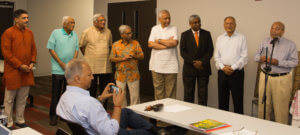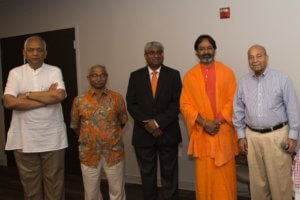What is Niskāmakarma?

The universal law of karma states that there is a reaction for every action. Although a perfect system of justice, this law can potentially keep us within samsāra when action is performed as kāmakarma or as driven by pleasure. We must inevitably reap the fruits of our pāpa and puṇya throughout our lifetimes.
Niṣkāmakarma provides a path out of transmigration. It literally means action without desire (niṣ – without, kāma – desire, karma – action). But desire for what? Is it wrong to have any desire at all? Even noble ones? The desire for the fruits of our pleasure-driven actions must be avoided.
The Upaniṣads state that this type of selfless action or Niṣkāmakarma is essential on the path to spiritual progress, and an eventual Mokṣa – the highest Puruṣārtha (goal of humankind) and the ultimate objective of existence.
Is this mindset practical to everyday life? In today’s world, the anticipated outcomes drive our every action. Financial, time, and effort investments are not made without expecting a return. Projects and life decisions are carefully planned and executed with the anticipation of a specific outcome. What, therefore, is the value of action without desire, and is it practical or even possible in a world where instant gratification has become the norm?
First, let us understand why we perform actions with attachment. Chārvākha philosophy states that the boundaries of sense perception draw the limitations of reality. Therefore, that we are the body made from matter and that nothing exists beyond the perceivable makes it acceptable for one’s actions to be motivated solely by an anticipated pleasurable outcome. However, Vedānta clarifies that we are jīva (embodied ātma/soul) within the jagat. The physical body is but one kośa (sheath) of the śarīra (physical body), whose function is to act as the vehicle of karmas (actions) that work towards freeing the ātma from saṃsāra. Without fully understanding this, we tend to identify with and according to the śarīra
Even as followers of Vedānta in theory, our practice and behaviors often align more with the Chārvākha philosophy. Identifying as physical “bodies,” the senses trap the mind and enslave the intellect, directing most of our karmas in the relentless pursuit of never-ending material desires.
We ceaselessly seek to satisfy the perceptions of pleasure that are slow in coming and quick to end, keeping us caught in constant pursuit. Intoxicated by the pull of the sense organs to the sense objects, the mind is tossed in multiple competing directions. Yet, despite the staggering time and efforts invested in sense fulfillment, there is never satiation of what has become an invariably bottomless pit of desire.
The Upaniṣads clarify that this association with the body comes from avidya or ignorance of the nature of the true Self. Emphasis on knowledge of the phenomenal (apara vidya), which, while necessary for survival and growth within the jagat, is incomplete and insufficient for reaching our full potential.
Vedānta teaches that desires arise only when there is an experience of lack or incompleteness. The perception that we are incomplete creates the need for something external or extra. As the body is limited, so does association with the body lead us to feel that we, too, are limited. And because of this, we are driven towards endless activity to fill the perceived lack, and we become attached to the karmaphalas or fruits of our actions.
What is the danger of kāmakarma?
The severity of performing karma with selfish desire is two-fold.
1. Firstly, the mind becomes confused and saturated with constant decision points as the senses compete for enjoyment. As soon as one desire appears to be fulfilled, another emerges, creating a perpetual web of vain attempts to keep each sense organ satisfied. This combination drives karma towards preyas (short-term temporary gains) over śreyas (permanent freedom and bliss). Accordingly, the intellect develops frustration and is fatigued by the insatiable chase, unable to function effectively within the world. There is no peace, no contentment, and only short-lived pleasure.
While this makes for a very frustrating and potentially unhappy life, the even greater danger lies in the longer-term risk.
2. Desire-driven karma imprisons us within the barriers of samsāra indefinitely. Continuous repetition of actions results in the formulation of samskāras (psychological imprints) which, with further repetition, strengthen into vāsanas or habits. Reinforced vāsanas develop into vṛttis or tendencies, which become our habituated default mindsets that direct our karmas in the unrelenting quest of desire after desire.
Illustration 1 – The Karmic Cycle
At death, these samskāras follow the ātma into a new body, guiding its continued journey through the birth-cycle in jagat, shaped by its karma, knowledge, and desires, in accordance with the laws of transmigration.
The Kathopaniṣad 2.2.7 states:
“योनिमन्ये प्रपद्यन्ते शरीरत्वाय देहिनः । स्थाणुमन्येऽनुसंयन्ति यथाकर्म यथाश्रुतम् ॥
Some jīvas enter the womb to be embodied as organic beings, and some go into non-organic matter according to their work and according to their knowledge.”
But how does niṣkāmakarma help us to avert these dangers and free us from samsāra?
To read the Part 2 of this blog, click here.










